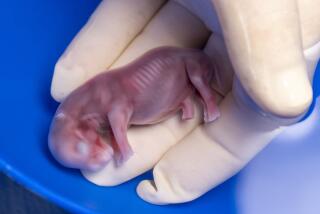Science / Medicine : Zoos Test Hormone Therapy to Aid Reproduction : Animals: Tests on gorillas, which have had particular trouble conceiving and giving birth in captivity, have had some success.
- Share via
WASHINGTON — Zoos have begun administering hormones to animals to try to improve the reproductive success rate. That effort already has resulted in a successful pregnancy for a 16-year-old gorilla at the Toledo, Ohio, Zoo and has produced unsuccessful pregnancies in three other females, researchers recently told a meeting of the American Assn. for the Advancement of Science.
The results are important because 48% of gorillas in zoos have never been able to conceive and another 15% have been able to bear only one offspring, said endocrinologist Nancy Czekala of the Center for the Reproduction of Endangered Species at the San Diego Zoo. Czekala is working with the Toledo Zoo and several other zoos.
Czekala’s findings are the first to link abnormal hormone levels in gorillas to lack of reproductive success.
Reproduction of gorillas in zoos has long been a problem. Although they have been kept in zoos since 1855, the first birth by a captive female did not occur until 1956, over a century later. Female gorillas in the wild, in contrast, “are always pregnant or lactating,” Czekala said.
To determine the role of hormones in the animals’ failure to reproduce, Czekala collected daily urine samples from females who were reproductively successful and those who were not.
She found that the monthly rise and fall of feminine hormones in the animals was similar to that of humans. But among the females who had fertility problems, she observed that the concentration of hormones called progestins did not rise nearly as much as that of reproductively successful gorillas during the so-called luteal phase--the period after ovulation.
High levels of progestins during this period facilitate the implantation of fertile eggs in the womb. About 10% of infertility in humans has been attributed to below-normal production of progestins during the luteal phase.
Czekala has no evidence about what causes the lowered levels of progestins in the gorillas, but in humans it is thought that stress is a major contributor, she said. Many of the zoo gorillas, especially those in older zoos, certainly experience stress from confinement in undesirable environments, she added.
The condition is treated in humans by giving supplemental quantities of the hormone progesterone after conception. Czekala tried this therapy in four female gorillas and was partially successful.
One of the animals, named Happy, was 16 years old, an age by which she should have had two offspring already. Czekala treated her in 1988 and Happy gave birth for the first time.
In three other animals, however, the pregnancies did not last beyond a week. Czekala attributes the failure to the necessity of administering the progesterone orally, a path by which it is not easily absorbed.
Humans are treated with suppositories, which are much more readily absorbed. “When I mentioned that to the keepers, they said that was not a possibility,” she chuckled. She is now searching for a more active form of the hormone.
Meanwhile, Czekala has been expanding the study by measuring hormone levels in free-living gorillas at the Karisoke Research Center in Rwanda, the mountain sanctuary established by Dian Fossey.
She has done this by following three female gorillas around every day for more than a month, collecting urine from the foliage on which it was deposited. “That’s not as easy as you might think,” she said. Male gorillas were especially curious about her interest in the urine, she said, and would often come up and examine her closely while she was collecting it.
The urine was then frozen and shipped back to San Diego for analysis.
The results showed that the hormone levels were very similar to those of the reproductively successful zoo animals and higher than those of the subfertile females. Those results suggest that the hormone supplement program “is on the right track,” she said, and that it should ultimately be more successful.





